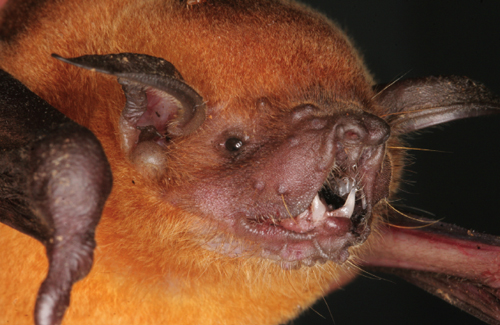Bats Gorge During Exercise
By Elsa Youngsteadt
Analysis of bat breath reveals an unusual ability to digest rich food while working out
Analysis of bat breath reveals an unusual ability to digest rich food while working out

DOI: 10.1511/2011.89.124
Like marathoners nursing packets of sweet energy gel, foraging bats have to nourish their hard-working muscles on the go. But recent experiments reveal that flying bats can quickly refuel not only with sugary foods, but also with proteins and fats—nutrients that would give other exercising mammals a bellyache.
This unusual metabolic ability allows some bats to hunt insects for up to seven hours each night, all the while maintaining the most demanding form of locomotion: flapping flight. In human terms, a bat’s routine “would be like eating a 35-pound steak and then exercising at really high intensity … without getting any stomach cramps,” says Chris Guglielmo, a physiological ecologist at the University of Western Ontario in London, who was not involved in the new experiments.

Image courtesy of Christian Voigt.
A run-of-the-mill mammalian metabolism wouldn’t be up to that challenge. Most mammals, including humans, sustain intense exercise with stored glycogen and fat. Sugar eaten during a workout can help a little bit, but richer foods are only a burden because the body has to slowly convert them into fat and glycogen that muscles can use.
Distance athletes “hit the wall” with fatigue when their glycogen reserves run out. Bats, however, “cannot afford to hit the wall,” says Christian Voigt, a behavioral physiologist at the Leibniz Institute for Zoo and Wildlife Research in Berlin, who led the study. “They have to remain airborne all the time, so they have to find another solution to this problem.”
The solution, it turns out, is to skip the fat and glycogen middlemen and convert insects directly into flight power. Voigt and his colleagues captured lesser bulldog bats (Noctilio albiventris) in Panama and subjected them to a high-tech breathalyzer test to see if they were flying on insect fuel or stored fats.
The breath test works because bat fat and insects contain stable carbon isotopes, carbon-12 and carbon-13, in different ratios. (The bats’ enzymes preferentially incorporate carbon-12 into fat.) The carbon dioxide a bat exhales will have the same isotope ratio as whichever fuel its muscles are burning.
Captive bats that hadn’t eaten for a day were clearly living off their fat reserves, their exhalations rich in carbon-12. But within 45 minutes of a mealworm feast, their breath switched almost completely to the insect isotope ratio. Free-living bats caught in the act of hunting ants and moths also exhaled mainly insect-derived carbon dioxide, Voigt and his team reported in the October issue of the journal Ecology.
According to Voigt’s calculations, the flying bats fueled more than 90 percent of their metabolism directly from protein-rich insects. That’s in contrast to humans, who can only absorb simple carbohydrates during exercise—and only enough to satisfy about a quarter of their muscles’ energy demands.
Indeed, no other mammal is yet known to use ingested fats and proteins as quickly and extensively as the bats that Voigt studied. Still, Guglielmo wonders if the phenomenon is really limited to bats. If other animals are capable of similar tricks, he says, birds such as swallows that spend hours on the wing hunting insects would be a good place to start looking.
Click "American Scientist" to access home page
American Scientist Comments and Discussion
To discuss our articles or comment on them, please share them and tag American Scientist on social media platforms. Here are links to our profiles on Twitter, Facebook, and LinkedIn.
If we re-share your post, we will moderate comments/discussion following our comments policy.